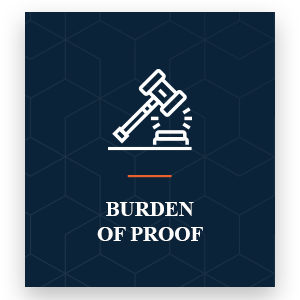What Is Personal Injury Law?
“Personal injury” is a common legal term used to describe harm to one’s body, mind, or emotional well-being. Personal injury law is the broad branch of law that handles conflicts where one person (intentionally or inadvertently) causes suffering, harm, injury, or unfair loss to another. It is closely related to tort law, which ensures the right to compensation when one person harms another’s legally protected interests.
Personal Injury Cases Fall Under Civil Law
In the United States, there are two predominant areas of law: criminal law and civil law. Although they share the common purpose of deterring wrongdoing, they differ in many critical ways. Personal injury cases fall under the civil branch of law — let’s take a look at the differences between criminal and civil law to understand why.
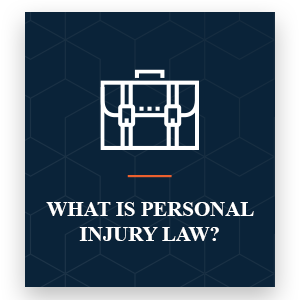
Criminal law describes “the law of crimes and their punishments,” according to Merriam-Webster. It encompasses offenses against society at large rather than offenses against a private individual or entity. This could mean a literal offense against the government itself (like assaulting a government official), but more commonly, it simply means breaking laws established by the government.
Criminal offenses are often regarded as more serious than civil offenses, and only a state or federal government can bring charges to initiate a criminal law case. Criminal cases are often more complex, require stricter standards of proof, have longer statutes of limitations, and carry much higher consequences than civil cases do. Some examples of types of criminal law disputes include assault, theft, driving under the influence, or obstruction of justice.
Civil law, according to Merriam-Webster, is “the law of civil or private rights.” It encompasses disputes between two private parties, such as individuals, groups of people, or organizations and companies. The offense that caused harm may not have been a criminal act (i.e., it may not have broken any established laws), but the harmed party is still permitted to seek justice and damages for any injuries sustained as a result of another’s behavior.
Because personal injury cases deal with conflicts between two private entities, they fall under the civil branch of law. However, if one single incident constitutes both a private injury and a public offense, it can result in parallel civil and criminal cases.
Types of Personal Injury Cases
There are many scenarios that may warrant a personal injury case. Any time a person or private entity causes harm to another through negligence, gross negligence, reckless conduct, intentional misconduct, or in some cases on the basis of strict liability, then the injured person is eligible to seek damages.
Types of personal injury cases include:
- Motor vehicle accidents: Car accidents, trucking accidents, motorcycle accidents, bus accidents, and even bike accidents are common catalysts for personal injury cases since most road accidents happen as a result of someone not being as careful as they should or failing to follow all the rules of the road, or because the road has not been properly maintained.
- Slip and fall accidents: These may also be a cause for personal injury cases if the property owner neglects their legal duty to keep the premises free of hazards.
- Medical malpractice: These cases can arise when a medical professional provides a substandard degree of care that results in injury to their patient. (It is important to note that poor results from treatment do not always mean medical malpractice has occurred.)
- Dangerous and defective products: If a product does not work the way it should, it can lead to serious injury. Product designers and manufacturers are responsible for ensuring that their products are safe and that consumers have access to resources and information on how to use those products correctly; failure to ensure this could result in a product liability case.
- Wrongful death: When someone is killed due to another’s carelessness, surviving loved ones can file a wrongful death lawsuit to pursue damages.
- Premises liability: If someone is injured due to a dangerous condition (such as missing handrails, slippery floors, dangerous animals, or more) on someone else’s land, then the property owner may be held liable for damages in a premises liability case.
- Animal attacks: Dog bites and other animal attacks are often litigated as personal injury cases. In Maryland, under strict liability laws, pet owners are almost always liable for any damages caused by their pets.
- Intentional torts: When an injury is not accidental or the result of negligence, but is instead the result of an intentional act, then not only can the plaintiff file a personal injury claim in a civil case against the defendant, but the defendant is also likely to be criminally prosecuted.
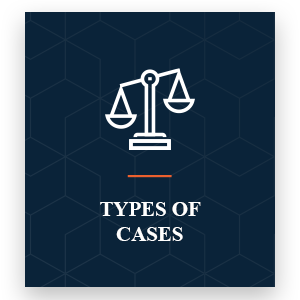
These are just a few examples of situations that could result in a personal injury suit. You can find more detailed information about each of these scenarios by browsing the resources on Murphy Falcon & Murphy’s practice areas page.
Determining Liability in Personal Injury Cases
How do you know if you have a legal basis for filing a personal injury claim or lawsuit? You must establish that the other party is at fault for the injuries you have sustained. This is one of the most important issues in any personal injury case since once a party has been recognized as being at fault, they will be held responsible for paying damages to the injured party by either a negotiated settlement or a court order.
Determining fault depends largely on the circumstances of the case, but if you are working with a personal injury attorney to file an injury claim, then you can expect them to investigate and identify all potentially at-fault parties. Often, insurance companies are held responsible for paying damages if the at-fault party carries liability insurance. If an injury claim is filed against the insurance company, then they will generally conduct their own investigation to determine liability.
If all parties involved cannot reach an agreement, the personal injury claim may accelerate to a personal injury lawsuit, bringing the case before a civil court jury to determine who, ultimately, is at fault.
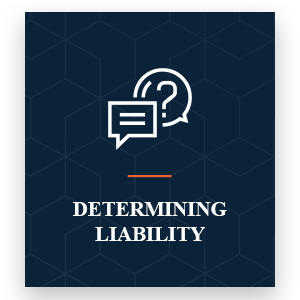
How is Fault Established?
Negligence
Most personal injury cases are established on the basis of one party’s negligence. In order to bring an injury claim based on negligence, you (or your attorney) must be able to demonstrate four things:
- The defendant owed a duty of care to the plaintiff.
- The defendant breached this duty of care.
- This breach resulted in loss or injury to the plaintiff.
- The plaintiff suffered demonstrable loss or injury.
If all four of these conditions are met, then you have a strong case for a personal injury claim on the basis of negligence. Let’s look at each of these four elements in more detail.
Gross Negligence
Sometimes, a person’s behavior crosses the boundary from carelessness into outright recklessness: an extreme departure from the conduct that a reasonably prudent person would ordinarily take. If a plaintiff can demonstrate that the defendant not only met all the standards of ordinary negligence but also acted with a conscious indifference to their consequences and a reckless disregard for others, then they may claim “gross negligence.” Even in cases where the defendant did not purposefully intend to cause harm, if the courts find that they had a conscious or willful disregard of their need to use reasonable care, and their action was likely to cause harm, they may be found grossly negligent.
For example, a driver running a stop light and causing an injury collision is typically a case of ordinary negligence. However, if that driver had 15 beers before getting in the car, they may be found grossly negligent.
A gross negligence ruling carries higher penalties than ordinary negligence: it can increase the damages to be paid and even result in punitive damages, which are payments mandated for the express purpose of punishing the wrongdoer.

Negligence Per Se
In some injury cases, if there is a specific safety statute in place that the defendant has violated, then the plaintiff may be able to raise the negligence per se doctrine to make it faster and easier to recover damages.
To establish a negligence per se claim in Maryland, the plaintiff first and foremost needs to prove that the statute covers the defendant’s conduct: the statute was specifically passed to prevent the defendant’s behavior which led to the accident, and to protect the plaintiff from sustaining the resulting injury.
After a court acknowledges that negligence per se applies, the plaintiff must prove only that the defendant violated the statute in question, and that this violation was the proximate cause of the plaintiff’s injuries. Notably, the plaintiff does not need to prove that the defendant knew about the statute.
Why pursue a negligence per se claim? Generally, the existence of a relevant statute makes it far easier to prove the defendant’s breach of their legal duty of care, removing the need for a jury to consider whether their actions were reasonable. Their duty of care is automatically assumed with an applicable rule, regulation, or statute, and their breach of that duty is automatically assumed with the violation of that statute. Negligence per se strengthens the plaintiff’s case and makes it more likely to recover greater damages.

Intentional Conduct
Although the majority of injury claims involve traditional or gross negligence, there are several other ways to establish fault. While negligence deals with injuries resulting from accidents or carelessness, intentional torts deal with legal wrongs that are committed on purpose, with the defendant acting with the intent to cause harm.
Common intentional tort injury claims include sexual crimes, assault and battery, and false arrest and imprisonment. Often, when a defendant has caused injury by acting with intentional conduct, their actions will result in both the victim pursuing damages through a civil injury lawsuit and in the local prosecutor filing criminal charges. Victims of intentional torts are eligible to recover all damages, including punitive ones.

Strict Liability
In some types of personal injury cases, a defendant can be found liable for damages even if they did not act with fault or negligence. The doctrine is limited to very specific circumstances, and it varies from state to state, but generally speaking, it applies in three types of situations:
1. Product Liability
Even if a product manufacturer uses every measure of reasonable care to sell a safe product, if they put a defective product on the market and it causes injury, then they can be found strictly liable for damages.
2. Animal Bites
If someone is bitten or otherwise injured by a pet, then the owner can be found strictly liable for damages, unless they can prove that they had no prior knowledge of the animal’s dangerous behavior.
3. Abnormally Dangerous Conditions
If a person is participating in an inherently dangerous activity or creates dangerous conditions that end up causing injury, then even if they took precautions to keep others safe, they may be found strictly liable.
To decide if an activity is abnormally dangerous, Maryland courts typically assess six factors:
- Does the activity pose a high risk of some level of harm?
- Is the resulting harm likely to be great?
- Can the risk not be eliminated by exercising reasonable care?
- Is the activity not commonly practiced in the community or in the specific circumstances?
- Is the location inappropriate for the activity?
- Does the danger the activity poses outweigh the value it offers the community?
If the answers to these questions are yes, the court is likely to rule that the activity is abnormally dangerous, opening the defendant to strict liability for damages.
After strict liability has been established, the plaintiff will still need to show that the defendant’s action caused some kind of harm and that the type of harm caused merits the awarding of damages.
Contributory Negligence
What if multiple parties are at fault in your personal injury case? For example: let’s say a man drops his phone in his car and leans down to reach for it. As he does so, he brakes unexpectedly on a section of road where he shouldn’t be stopping. The woman behind him is texting and driving. As a result, she doesn’t see him braking in time and rear-ends him. They both sustained injuries in the collision and both wish to pursue damages.
Given these facts, both drivers were acting negligently leading up to the accident. They each share some portion of the blame. In cases of shared fault, how do courts decide who is culpable and who is eligible to receive damages?
Most states use a comparative negligence doctrine to address shared fault. In this system, the court tries to determine each party’s share of the blame and assign an appropriate share of the damages. In this example, if the court found that the braking driver was 33% responsible for the accident, and the texting driver was 66% responsible, then they can both still claim damages from the other party, but the compensation amount will be reduced by their percentage of the blame.
However, Maryland is one of a handful of states that use a doctrine of contributory negligence. Under this rule, if you are even 1% at fault for the injury, you cannot collect any damages from the party who is 99% at fault. This is part of the reason it is critical to have an experienced injury attorney to review your case and represent you; they will help you build the strongest possible case to avoid being assigned any percentage of blame.
Burden of Proof in a Personal Injury Case
In the United States, our legal system runs on the principle of “innocent until proven guilty.” Because of this, in any personal injury case, it is up to the injured party to convince the court that the person being sued is responsible for causing their injuries. The burden of proof falls on the plaintiff to prove the defendant is guilty, rather than on the defendant to prove their innocence. Moreover, this burden of proof must be applied to every element of the case.
But just how convincing does the plaintiff need to be? The standard of proof in matters of civil law is called a “preponderance of evidence,” and it requires only that the plaintiff convinces the court that it is “more likely than not” that the defendant should be held liable for their injuries. Their version of the story must have at least a 51% likelihood of being true. This is in contrast to criminal law cases, where the plaintiff must prove the defendant’s guilt “beyond a reasonable doubt,” or above the threshold of 90% certainty.
The defendant does not need to convince the courts of their version of events, with one exception:
Affirmative Defense
Sometimes, even if a plaintiff successfully convinces the court of every aspect of their injury claim, the defendant may prove additional facts that pose a complete or partial defense to the claim, eliminating or reducing the defendant’s culpability. There are more than 100 examples of potential affirmative defenses, including duress, assumption of risk, and self-defense.
If a defendant wishes to prove an affirmative defense, then they must meet the preponderance of evidence burden of proof. For example, if a plaintiff is an athlete who is injured during a sports game, and raises a personal injury claim against his coach, then the coach may bring up the assumption of risk as an affirmative defense. He need only convince the court that the plaintiff “more likely than not” agreed to participate in a sport knowing the inherent risks of playing.
Types of Damages in a Personal Injury Case
The purpose of damages in personal injury cases is to compensate the injured party. In some cases, it can be challenging to assign a dollar amount. Money can’t “fix” most injuries. But, the goal is to try to provide some measure of justice and to minimize the future consequences of the event.
Depending on the event and type of injury, the different types of damages include:

 Medical Bills
Medical Bills
Medical care is expensive. Even a single visit to the doctor with a few lab tests can be enough to cause financial hardship. In some cases, there is a need for life-long care. An award that includes medical damages will need to include enough to cover future medical costs.
 Lost Wages
Lost Wages
Injuries frequently result in time off from work. Lost wages, including wages that would have been earned over the rest of the plaintiff’s lifetime, had the injury not occurred, can be quite substantial. They can be periodic or permanent.
 Emotional Distress
Emotional Distress
Injuries are upsetting and can cause emotional distress. Psychiatric records or a diagnosis of post-traumatic stress disorder (PTSD) can prove that there should be damages to compensate for emotional distress.
 Punitive Damages
Punitive Damages
Punitive damages are allowed in Maryland. Unlike other damages that compensate for loss, punitive damages are meant to punish. These are awarded at the discretion of the jury or the judge. Generally, they are for cases that involve an act of malice or gross negligence.
 Pain & Suffering
Pain & Suffering
Pain and suffering damages usually take into account the actual financial loss and then use a multiplier to come up with a final number. Read more on the topic below.
How Much Can Be Awarded for Pain & Suffering?
A common question we hear is: how much can be awarded for pain and suffering? Pain and suffering is a non-economic category of damages. It refers to intangible harms that do not come with a set price tag such as medical bills or lost wages. Pain and suffering can encompass both physical and emotional pain.
The amount that the plaintiff will receive for pain and suffering depends on many different factors, including:
- Severity and extent of injuries
- Impacts the injuries will have on the victim’s life
- Age of the victim
- The nature of the defendant’s actions
- How traumatic the injury was for the plaintiff
It is up to the plaintiff and their lawyer to prove pain and suffering damages to a jury. The jury will then calculate the award amount using either the multiplier or a per diem method:
The multiplier method multiplies the amount of compensatory damages by a number from one to five depending on the severity of harm.
The per diem method calculates pain and suffering for each day the person is in recovery. The skill of your attorney affects the amount of pain and suffering damages the jury awards you.
Caps on Non-Economic Damages
Since it can be difficult to quantify the appropriate compensation for non-economic damages like pain and suffering, Maryland imposes a cap on non-economic damages.
As of 2019, the maximum recovery amount for pain and suffering damages in medical injury claims damages is $860,000.
In a wrongful death case with more than one beneficiary, this cap increases to $1,290,500, though plaintiffs are eligible to seek an additional $830,000 in a survival action.
The caps increase by $15,000 each year, as determined in the Maryland Code of Courts and Judicial Proceedings Section 3–2A–09.
The Steps in a Personal Injury Case
What does a standard personal injury case look like, step by step? How can you begin the process of filing a personal injury lawsuit? The process can be somewhat confusing, so we’re breaking down a typical personal injury claim:
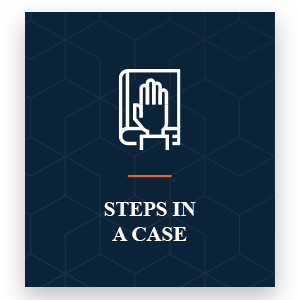
1
Find a Personal Injury Lawyer
After you receive initial treatment for your injuries, your next step should be getting in touch with a personal injury attorney. Although you do not have to hire an attorney in order to file an injury claim, having professional legal assistance often improves your chances of obtaining a favorable result. Getting appropriate compensation may prove more difficult than you were expecting, and you may encounter unforeseen challenges. Insurance companies may deny your claim, and medical bills may be piling up in the meantime, leaving you stuck with costs you can’t afford.
An experienced injury lawyer will be able to help in many ways:
An experienced Baltimore personal injury lawyer will be able to assess which cases are best to pursue. Furthermore, attorneys are able to examine situations and come up with a comprehensive list of damages that you will likely be eligible to recover.
If you are looking for a personal injury attorney in Baltimore, please contact us to get in touch with Murphy Falcon & Murphy’s experienced team.
2
Check the Statute of Limitations
Once you have found an attorney you feel confident working with on your injury case, you need to make sure that the statute of limitations has not passed for your type of case. This will likely come up during your initial consultation with the lawyer.
A statute of limitations is essentially a deadline that is set and determines when you can go to court to file a suit after an incident. Even if you are only filing an insurance claim, and don’t expect to take the matter to court, it’s a good idea to give yourself as much time as possible. That way, if a fair injury settlement cannot be reached and you end up needing to file a lawsuit, you will still be able to do so as long as the statute of limitations has not passed. If it has, you lose the right to bring your case to court.
In Maryland, most personal injury cases have a three-year statute of limitations. That means you have three years from the date of the incident to file an injury lawsuit.
3
Investigate the Case
Your attorney will launch a full, independent investigation of the claim. During this time, they will conduct interviews and go over any relevant reports and records, such as police reports, medical records and bills, photographs, witness testimony, and more. If appropriate, they may also collaborate with experts like accident reconstruction professionals, medical professionals, and anyone else with relevant expertise to the circumstances of your case.
They will use their findings to build your case, anticipate the possible defense of the opposing party, determine liability, and assess appropriate damages. Throughout this process, a good personal injury attorney will remain responsive and keep you informed.
4
Send the Demand Package and Settle Up-Front
Next, if they believe you have a legitimate case and that it can be settled outside of court, your attorney will put together a demand for settlement. The vast majority of personal injury cases end with a settlement before a lawsuit is ever filed. Settlement simply means that both parties negotiate to reach an agreement to drop the case. Most often, the plaintiff agrees to drop the lawsuit in exchange for compensation, typically a lower amount than the defendant could expect to pay after losing a court case. This saves both parties the time and money of going to trial.
The demand package will go to the other party’s attorney and/or insurance company, and it should include a letter outlining the case and detailing liability and demands. The opposing party will review the letter and then either reject it, accept it outright, or make a counteroffer.
Most personal injury attorneys prefer to wait to make demands until after the plaintiff has reached a point of “maximum medical improvement” (MIM). This is because, until medical treatment has ended and the plaintiff is as recovered as they can be, it is impossible to know how much the case is worth and what kind of damages to pursue.
5
If No Settlement Can Be Reached, File the Lawsuit
It is estimated that only about 5% of personal injury cases go to trial, but if you cannot reach a settlement agreement up-front with the opposing party, then you and your attorney may be on your way there. The next step is to file a lawsuit.
6
Build Your Case in the Discovery Phase
If you’re taking your case to trial, then your injury attorney will commence with the discovery process. During this time, they will thoroughly investigate the opposing party’s legal claims and defenses, gathering all of the information they need to build a case that is compelling enough to convince the court.
During this phase, either party may also file motions with the court, requesting that the case be dismissed, delayed, or for a judgment to be reached.
7
Revisit Settlement Through Mediation
At this point in the process, it’s common to revisit the possibility of settlement. A settlement can be reached at any point before the case goes to trial. Sometimes a settlement is negotiated between the attorneys, and other times it is established after a process of mediation, meaning both clients and both lawyers go before an objective third-party mediator to negotiate the settlement terms. Once an agreement is reached, it is put into writing, reviewed by the court, and finalized as a legally binding contract.
8
Go to Trial
At trial, the court will hear from both the plaintiff and the defendant before reaching a decision. The judge and jury will review the evidence and arguments presented by your injury lawyer, and then determine fault and possibly award damages.
Trial is a time-consuming and expensive process for everyone involved, which is why the majority of injury cases are settled beforehand.
9
Appeal
Depending on the circumstances of the case and how the trial went, the losing party may then appeal the case to have it reevaluated. There is a set deadline for filing an appeal; in Maryland, you have 30 days from the entry of judgment.

Why Choose Our Baltimore Personal Injury Attorneys?
- Our law firm has been a household name in Baltimore for over 70 years.
- We have some of the top injury lawyers in Maryland.
- Previous clients have recovered millions for their injuries.
Contact Us To Get Started Today
Maryland has a statute of limitations on most personal injury claims of three years. This limits the amount of time you have to take legal action on your injury. If you do not file a claim within this time limit, you can lose the ability to receive compensation as a result. Don’t run out of time before you can receive compensation. Contact an injury attorney right away to see if you can still file a claim.
With our experience and dedication, we fight for the best possible outcome for our clients. At Murphy Falcon & Murphy, we are prepared to work with you to get the results you deserve. If you have experienced a serious personal injury because of the negligence or intentional actions of another, you may be eligible to file a claim.
We encourage you to explore your options with a Baltimore personal injury lawyer from our firm. Please call our firm to conduct a free consultation.
“These lawyers understand the world of medicine and physicians. They helped my family make sense of what happened, and helped us recover what was rightfully ours.” – Dana




